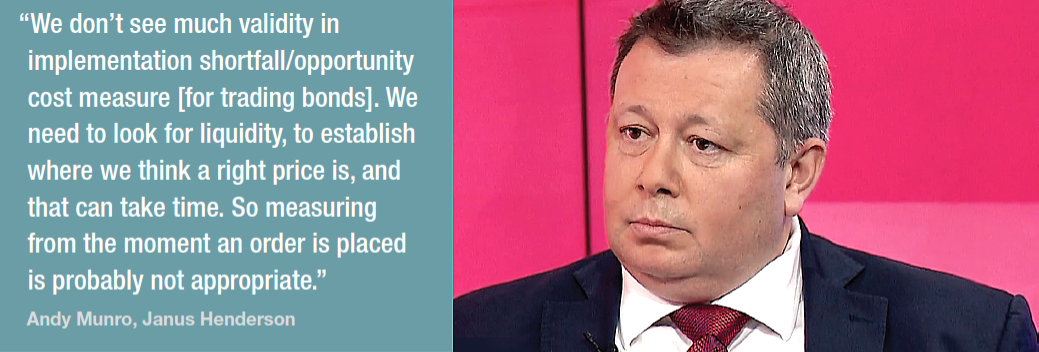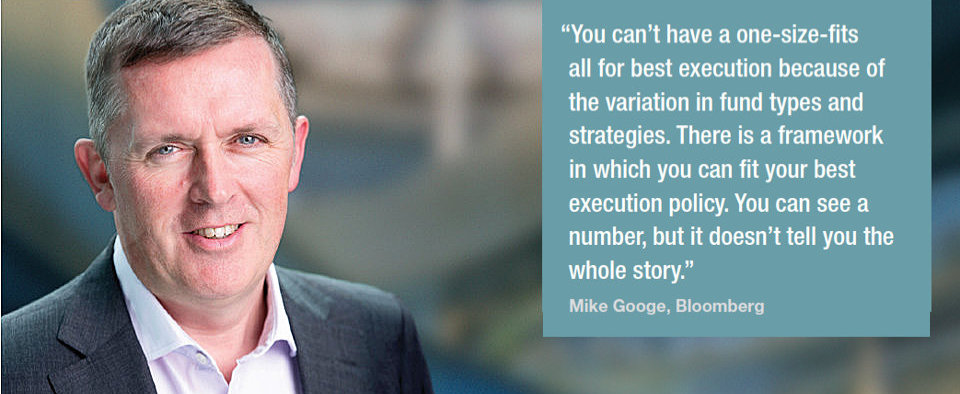The best execution conundrum
Market structure, risk trading and the nature of time-limited instruments make reporting of best execution for bonds a challenge. Dan Barnes reports.
The DESK launched in 2014 on the back of a comment from the global head of trading at a large asset manager: “I don’t even know what I am paying my bond brokers.”
The equity market had recently been the subject of Michael Lewis’s book ‘Flash Boys’; heads of trading were bombarded with questions about whether they were getting ripped off by a stock market structure that gave advantage to counterparties with fast data feeds.
However, relative to bond traders, equity traders had far greater transparency. Explicit fees and well-supported market data feeds for liquid instruments, which were in the majority. In bonds, three prices from three dealers was effectively needed for triangulation on the market price – although those prices were not guaranteed to be firm bids/offers when the trader called back to execute. The fee the dealer added was somewhere in the spread, there were no explicit charges.
The lack of transparency in bond trading means that a greater proportion of trading is conducted ‘on risk’ and prices are given on that basis by the sell-side, via the spread.
For best execution purposes, the frequent absence of data to provide benchmarks makes bond trading stand apart from equity trading, as does the price formation and liquidity discovery processes which are more involved.
In the equity markets, the availability of data has pushed traders towards using the transaction cost analysis (TCA) methodology, which looks at the price at which a stock traded, and compares it to the price at other points in time to assess the implementation shortfall, or change in price between the time an order is placed by the portfolio manager and the time the trade is executed. It will also capture other quoted prices on the market, and relative metrics such as volume and order size in order to compare one trade with another. The difference in execution approach can make that less useful for bond traders.

“We don’t see much validity in implementation shortfall/opportunity cost measure [for trading bonds],” says Andy Munro, global head of fixed income trading at Janus Henderson. “An equity trader can place an order in the market immediately and start working in bits of 100. We need to look for liquidity, to establish where we think a right price is, and that can take time. So measuring from the moment an order is placed is probably not appropriate.”
The capacity for bond traders to use a similar methodology is now being hotly debated, as the revised Markets in Financial Instruments Directive (MiFID II) has obliged traders to record and evidence best execution.

“In the equity world, nowhere does it say that transaction cost analysis has to be used,” says Carl James, head of fixed income trading at Pictet Asset Management. “However, the equity industry has decided to use TCA, which obsesses about the price or outcome. The regulator is laying a framework in place to say there are different methods to demonstrate best execution, and it is up to the industry to show we are able to do that, and by learning from the mistakes of TCA we can deliver a better more nuanced best execution analysis.”
The same, only different
Neither bond nor equity markets are homogeneous in terms of their liquidity profile. Some fixed income instruments see the same liquidity profile of blue chip equities, and small cap stocks might be as illiquid as high yield bonds. However the value of bonds is affected by their limited lifespan; both liquidity and value typically decline from the point of issuance.
As time-limited instruments, new bonds have to be issued to raise capital, creating a wider universe of instruments than is found in the equity market. Portfolios turn over as existing bonds expire.
The infrequency of trading in many bonds creates fewer price points on which a trader can assess the best price. In the US, the Trade Reporting and Compliance Engine (TRACE) provides that data, where it does exist. In Europe no such consolidated tape exists, although one is mandated under MiFID II.
“As more data becomes available to be analysed, we will can make more detailed conclusions,” says James. “We must monitor the situation so that we can leverage greater processing power and more data. There is the risk that non-practitioners put models forward, as we saw in equities, and so it is incumbent on those of us in the business to take a straightforward approach and to be able to defend it robustly.”
There are concerns that greater transparency could harm liquidity; while risk trading in equities is less common than it is for bonds, the same concerns were once prevalent in stock markets. In 2010, When the Committee of European Securities Regulators (CESR) – the precursor to the European Securities and Markets Authority (ESMA) – made recommendations to reduce delays for publishing large trades permitted under then MiFID’s existing reporting regime, the investment bank Credit Suisse published a report called ‘MiFID II: Hail CESR’ in which it argued that risk trading in equities could be harmed.
Author Mark Buchanan, then director for portfolio strategy, Europe, at Credit Suisse wrote, “If approved, CESR’s decision to reduce the length of time allowed for the deferred publication of large trades could result in increased premiums for risk trades and more volatility, as traders rush to complete orders before disclosing to the market.”
He argued the main impact would be on small and mid-cap stocks. However, equally if traders have visibility on prices on the market as a result of greater transparency, it can be argued that they are better able to price a risk trade.
Building a better model
In addition to market data, analysing best execution requires qualitative information more frequently than is found by using a simple TCA model on its own.
“You are looking for a decomposed view of the order lifecycle using a variety of measuring tools to detect discrete effects, and doing so in the context of the operation,” says Mike Googe, product manager for BTCA at Bloomberg. “Of all of those things, the most important is the context”.

As the price formation and liquidity discovery process is a more active one in bond markets, the back and forth between the portfolio manager and the trader can be more involved. Market illiquidity can mean an order takes two weeks to fill. The PM’s instructions may change during that time, which needs to be conveyed in the best execution report. Price is only one element of the value a trade delivers.
“You can’t have a one-size-fits all for best execution because of the variation in fund types and strategies,” says Googe. “There is a framework in which you can fit your best execution policy. You can see a number, but it doesn’t tell you the whole story.”
Best practice for many firms following the MiFID II framework involves a combination of a best execution policy, and the capture of quantitative and qualitative information around a trade, which can then be set against that policy to assess best execution.
“We have a layered analysis,” says Munro. “We assess whether we followed our processes via a decision tree, and if we did, then was the price we obtained good, in respect of the size of the order and market liquidity? Then post trade, we ask if we made the correct decisions.”
This information needs to be captured in such a way that it can be presented to clients, regulators and compliance teams. Where the head of desk may look on a daily and weekly basis at how many exceptions there were, the Best Execution Committee may look at it on a quarterly and monthly basis, and clients most commonly on an annual basis. Unpicking a trade in the analysis can be complex.
“If partners want to ask for detail on individual trades, which they can and sometimes do, they may not understand it is part of a larger trade,” notes Munro. “We don’t think it’s right to show them other peoples’ orders if they are asking for granularity, so there needs to be trust that we are looking at the holistic outcome for all of our clients.”
Markets are becoming increasingly electronic, and as technology advances, it is better able to capture and represent information of the complexity seen in the fixed income markets. With the regulatory imperative of MiFID II the pace of change within asset managers will need to step up, as best execution models are tested.
“The risks you face if you aren’t able to prove and test best execution are threefold,” says James. “The regulator has demanded a higher hurdle of evidence to support best execution, and will therefore want to see this achieved. Clients are asking more detailed questions and will not look at you favourably compared with other asset managers that they use, if you are unable to provide this granularity. And, ultimately, you are going to be losing alpha as your funds underperform. So there is a downward spiral.”
©Markets Media Europe 2025
























